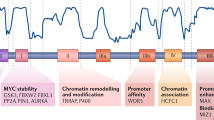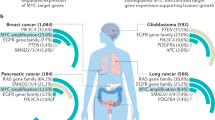Abstract
Increased expression of the oncogenic transcription factor c-Myc causes unregulated cell cycle progression1. c-Myc can also cause apoptosis, but it is not known whether the activation and/or repression of c-Myc target genes mediates these diverse functions of c-Myc. Because unchecked cell cycle progression leads to hyperproliferation and tumorigenesis, it is essential for tumour suppressors, such as p53 and p19ARF (ARF), to curb cell cycle progression in response to increased c-Myc (refs 2, 3). Increased c-Myc has previously been shown to induce ARF expression, which leads to cell cycle arrest or apoptosis through the activation of p53 (ref. 4). Here we show that ARF can inhibit c-Myc by a unique and direct mechanism that is independent of p53. When c-Myc increases, ARF binds with c-Myc and dramatically blocks c-Myc's ability to activate transcription and induce hyperproliferation and transformation. In contrast, c-Myc's ability to repress transcription is unaffected by ARF and c-Myc-mediated apoptosis is enhanced. These differential effects of ARF on c-Myc function suggest that separate molecular mechanisms mediate c-Myc-induced hyperproliferation and apoptosis. This direct feedback mechanism represents a p53-independent checkpoint to prevent c-Myc-mediated tumorigenesis.
This is a preview of subscription content, access via your institution
Access options
Subscribe to this journal
Receive 51 print issues and online access
$199.00 per year
only $3.90 per issue
Buy this article
- Purchase on Springer Link
- Instant access to full article PDF
Prices may be subject to local taxes which are calculated during checkout




Similar content being viewed by others
References
Oster, S. K., Ho, C. S., Soucie, E. L. & Penn, L. Z. The myc oncogene: MarvelouslY complex. Adv. Cancer Res. 84, 81–154 (2002)
Sherr, C. J. The INK4a/ARF network in tumour suppression. Nature Rev. Mol. Cell Biol. 2, 731–737 (2001)
Pelengaris, S., Khan, M. & Evan, G. c-MYC: More than just a matter of life and death. Nature Rev. Cancer 2, 764–776 (2002)
Zindy, F. et al. Myc signaling via the ARF tumor suppressor regulates p53-dependent apoptosis and immortalization. Genes Dev. 12, 2424–2433 (1998)
Weber, J. D., Taylor, L. J., Roussel, M. F., Sherr, C. J. & Bar-Sagi, D. Nucleolar Arf sequesters Mdm2 and activates p53. Nature Cell Biol. 1, 20–26 (1999)
Datta, A. et al. Myc-ARF interaction inhibits the functions of Myc. J. Biol. Chem. 279, 36698–36707 (2004)
Grandori, C. & Eisenman, R. N. Myc target genes. Trends Biochem. Sci. 22, 177–181 (1997)
Greenberg, R. A. et al. Telomerase reverse transcriptase gene is a direct target of c-Myc but is not functionally equivalent in cellular transformation. Oncogene 18, 1219–1226 (1999)
Wu, K. J. et al. Direct activation of TERT transcription by c-MYC. Nature Genet. 21, 220–224 (1999)
O'Hagan, R. C. et al. Myc-enhanced expression of Cul1 promotes ubiquitin-dependent proteolysis and cell cycle progression. Genes Dev. 14, 2185–2191 (2000)
Marhin, W. W., Chen, S., Facchini, L. M., Fornace, A. J. Jr & Penn, L. Z. Myc represses the growth arrest gene gadd45. Oncogene 14, 2825–2834 (1997)
Oster, S. K. et al. Myc is an essential negative regulator of platelet-derived growth factor beta receptor expression. Mol. Cell. Biol. 20, 6768–6778 (2000)
Xiao, Q. et al. Transactivation-defective c-MycS retains the ability to regulate proliferation and apoptosis. Genes Dev. 12, 3803–3808 (1998)
Evan, G. I. et al. Induction of apoptosis in fibroblasts by c-myc protein. Cell 69, 119–128 (1992)
Harrington, E. A., Bennett, M. R., Fanidi, A. & Evan, G. I. c-Myc-induced apoptosis in fibroblasts is inhibited by specific cytokines. EMBO J. 13, 3286–3295 (1994)
Lenahan, M. K. & Ozer, H. L. Induction of c-myc mediated apoptosis in SV40-transformed rat fibroblasts. Oncogene 12, 1847–1854 (1996)
Amanullah, A., Liebermann, D. A. & Hoffman, B. p53-independent apoptosis associated with c-Myc-mediated block in myeloid cell differentiation. Oncogene 19, 2967–2977 (2000)
Fukasawa, K., Wiener, F., Vande Woude, G. F. & Mai, S. Genomic instability and apoptosis are frequent in p53 deficient young mice. Oncogene 15, 1295–1302 (1997)
Korgaonkar, C., Zhao, L., Modestou, M. & Quelle, D. E. ARF function does not require p53 stabilization or Mdm2 relocalization. Mol. Cell. Biol. 22, 196–206 (2002)
Sakamuro, D. et al. c-Myc induces apoptosis in epithelial cells by both p53-dependent and p53-independent mechanisms. Oncogene 11, 2411–2418 (1995)
Trudel, M. et al. c-myc-induced apoptosis in polycystic kidney disease is Bcl-2 and p53 independent. J. Exp. Med. 186, 1873–1884 (1997)
Tsuji, K. et al. p53-independent apoptosis is induced by the p19ARF tumor suppressor. Biochem. Biophys. Res. Commun. 295, 621–629 (2002)
Weber, J. D. et al. p53-independent functions of the p19(ARF) tumor suppressor. Genes Dev. 14, 2358–2365 (2000)
Jacobs, J. J. et al. Bmi-1 collaborates with c-Myc in tumorigenesis by inhibiting c-Myc-induced apoptosis via INK4a/ARF. Genes Dev. 13, 2678–2690 (1999)
Eischen, C. M., Weber, J. D., Roussel, M. F., Sherr, C. J. & Cleveland, J. L. Disruption of the ARF-Mdm2-p53 tumor suppressor pathway in Myc-induced lymphomagenesis. Genes Dev. 13, 2658–2669 (1999)
Haviernik, P., Schmidt, M., Hu, X. & Wolff, L. Consistent inactivation of p19(Arf) but not p15(Ink4b) in murine myeloid cells transformed in vivo by deregulated c-Myc. Oncogene 22, 1600–1610 (2003)
Oster, S. K., Mao, D. Y., Kennedy, J. & Penn, L. Z. Functional analysis of the N-terminal domain of the Myc oncoprotein. Oncogene 22, 1998–2010 (2003)
Conzen, S. D. et al. Induction of cell cycle progression and acceleration of apoptosis are two separable functions of c-Myc: transrepression correlates with acceleration of apoptosis. Mol. Cell. Biol. 20, 6008–6018 (2000)
Soucek, L. et al. Omomyc, a potential Myc dominant negative, enhances Myc-induced apoptosis. Cancer Res. 62, 3507–3510 (2002)
Gregory, M. A., Qi, Y. & Hann, S. R. Phosphorylation by glycogen synthase kinase-3 controls c-myc proteolysis and subnuclear localization. J. Biol. Chem. 278, 51606–51612 (2003)
Acknowledgements
We thank C. Sherr and S. Hiebert for pCMV5-ARF and ARF-/- MEFs, G. Zambetti for DKO MEFs, R. DePinho for htert-SEAP and cul1-luc, L. Penn for gadd45-luc and pdgfβr-luc, E. Ruley for p53-/- MEFs, J. Pietenpol for REF 112 cells, and J. Sedivy for HO16 cells. We also thank R. Eisenman for critical review of the manuscript. This work was supported by grants from NIH to S.R.H.
Author information
Authors and Affiliations
Corresponding author
Ethics declarations
Competing interests
The authors declare that they have no competing financial interests.
Supplementary information
Supplementary Methods
Methods used for this study not described in the main article, including details on construction of expression vectors, cell culture, transfection, generation of cell lines, all PCR primers used, northern blot analysis, cell proliferation and apoptosis assays. (DOC 46 kb)
Supplementary Figure 1
Analysis of the effects of ARF on additional c-Myc target gene reporters and on the expression of additional endogenous c-Myc target genes not shown in main article. (PPT 115 kb)
Supplementary Figure 2
Co-immunoprecipitation analysis of ARF and c-Myc with Max, which was described, but not shown, in main article. (PPT 54 kb)
Supplementary Figure 3
Immunoblot analysis of c-Myc, c-MycER, ARF, p53, and p21 protein expression in the cell lines used for this study. (PPT 186 kb)
Supplementary Figure Legends
Legends to Supplementary Figures 1-3. (DOC 21 kb)
Rights and permissions
About this article
Cite this article
Qi, Y., Gregory, M., Li, Z. et al. p19ARF directly and differentially controls the functions of c-Myc independently of p53. Nature 431, 712–717 (2004). https://doi.org/10.1038/nature02958
Received:
Accepted:
Published:
Issue Date:
DOI: https://doi.org/10.1038/nature02958
This article is cited by
-
RUNX3 inactivates oncogenic MYC through disruption of MYC/MAX complex and subsequent recruitment of GSK3β-FBXW7 cascade
Communications Biology (2023)
-
ARF suppression by MYC but not MYCN confers increased malignancy of aggressive pediatric brain tumors
Nature Communications (2023)
-
Upregulation of 5′-terminal oligopyrimidine mRNA translation upon loss of the ARF tumor suppressor
Scientific Reports (2020)
-
Impact of c-MYC expression on proliferation, differentiation, and risk of neoplastic transformation of human mesenchymal stromal cells
Stem Cell Research & Therapy (2019)
-
BRD7 expression and c-Myc activation forms a double-negative feedback loop that controls the cell proliferation and tumor growth of nasopharyngeal carcinoma by targeting oncogenic miR-141
Journal of Experimental & Clinical Cancer Research (2018)
Comments
By submitting a comment you agree to abide by our Terms and Community Guidelines. If you find something abusive or that does not comply with our terms or guidelines please flag it as inappropriate.



